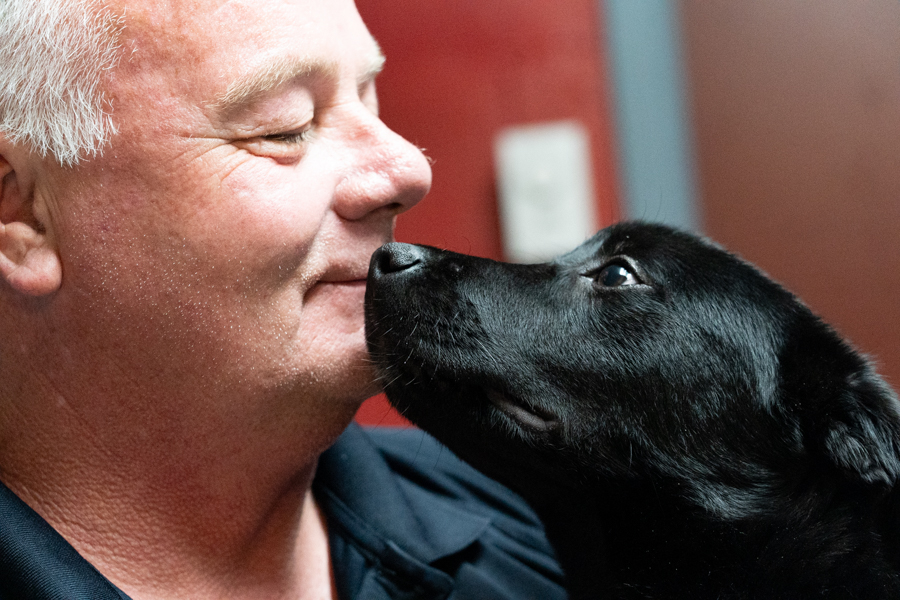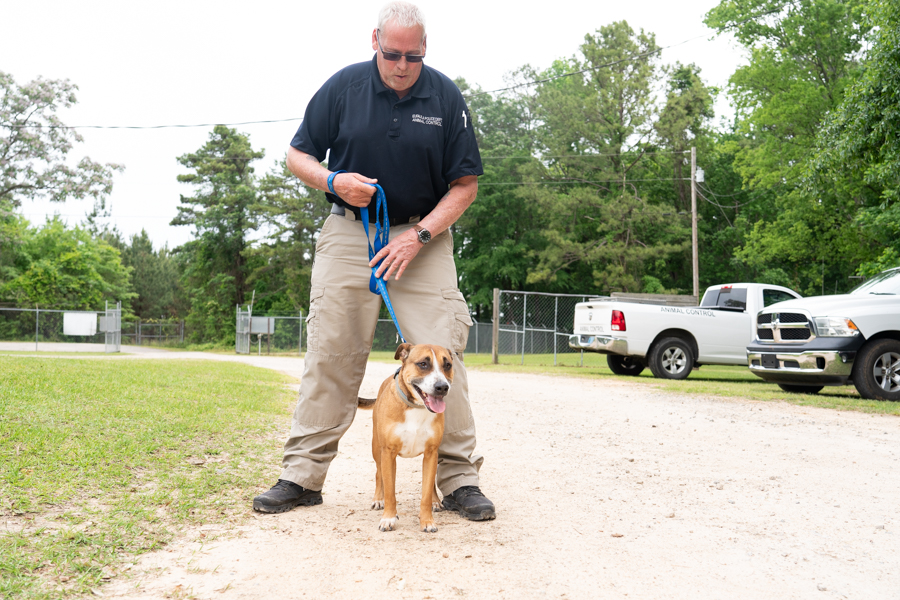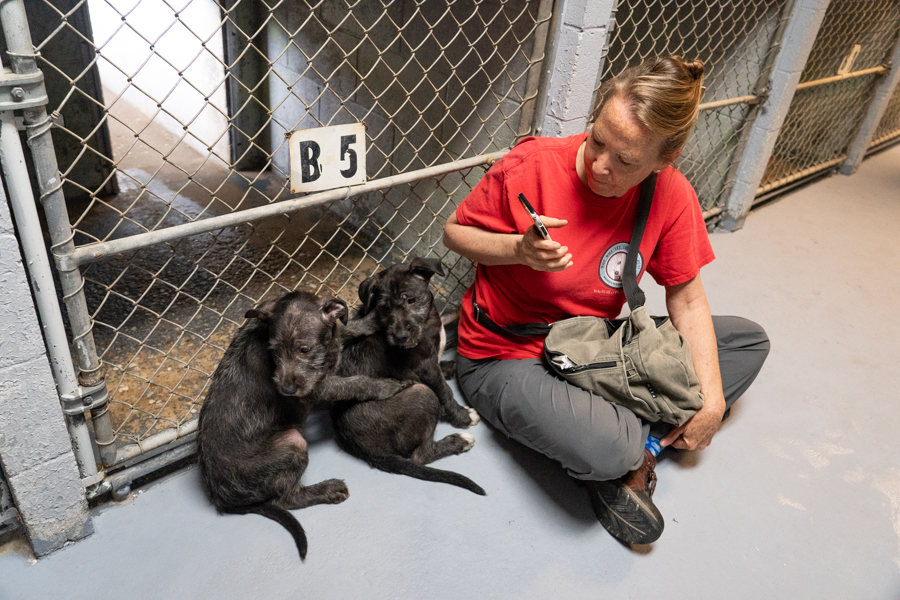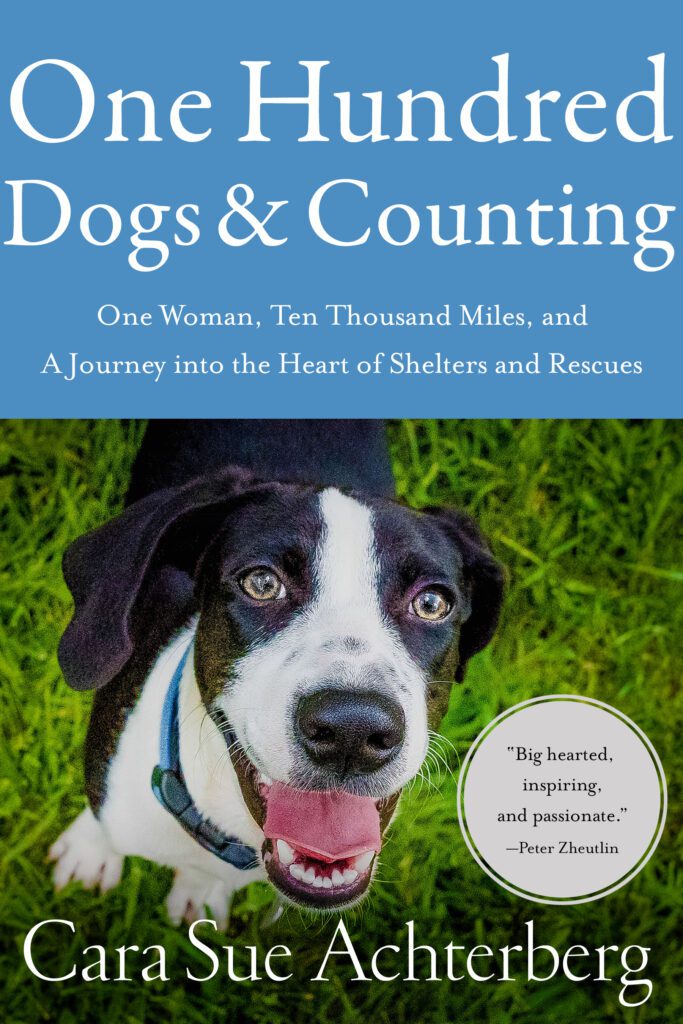Daniel and Gary at Eufaula Al Animal Control defy the stereotype. Many of the men we meet in shelters, especially ACOs, tend to be gruff, all business, following the rules, and a bit indifferent to the dogs in their care.
I don’t want to get anyone in trouble, but let me tell you, they are none of those things. They truly care about the dogs at their shelter.
The county ordinance states that dogs who come in with collars should be held five days and the dogs without collars get only three days. After that, they should be put up for adoption and then euthanized if no one wants them (or a kennel is needed).
Daniel explained that in the very few times he’s had to take a dog to be euthanized (because it is vicious or already dying), he’s cried the whole way to the vet (and back). Gary has fourteen dogs at home (all but a couple came from EAC). These men make sure the dogs entrusted to their care get safe passage to a forever home or rescue.



They screen potential adopters carefully because they do not want to pick up the same dogs or have them returned. While Alabama has an ordinance that requires dogs adopted through their municipal shelters to be spayed or neutered, Eufaula County does not provide a budget for veterinary expenses (past practice has been to euthanize unclaimed dogs so there was no need for it). When Daniel approves an adopter he does so because he believes the adopter will have their new dog spayed/neutered.
The shelter is only given a budget for food, salaries, and the building utilities. There is no money for medical care, spay/neuter, deworming, flea/tick treatments, toys, treats, transport, or anything else.
Daniel buys what they don’t have himself. He just recently paid their vet bill ($3000). He’s been working as an ACO at the shelter for six years. When he arrived, the three coolers at the shelter were full of dead dogs. Suffice it to say, the previous leadership was not interested in saving animals, only controlling them.

Gary began working at the shelter in June. Prior to that, he was a trucker and he and his wife had a farm rescue on their property (with fourteen dogs and I can’t remember how many cats, I’d say they still operate a rescue, or at least a sanctuary).

They are both on call 24/7 and handle not just the animal control calls, but the cruelty investigations. Daniel’s biggest frustration is when they present a case to a judge and nothing more than a slap on the wrist results despite real evidence.
EAC is the first shelter we’ve visited in quite some time that accepts owner surrenders. They know that if they don’t, those same dogs are likely to come into their care eventually, and likely suffer in the meantime.
When we visited, they had just seven dogs (there are 14 kennels). They move their dogs out equally through adoptions and rescues. We met a beautiful six-month-old Belgian Malinois named Jada who was turned in by her owner (with AKC registration papers) because she couldn’t handle her. Jada is gorgeous and Daniel hopes to find someone who understands the breed to add her to their family. Jada would also make an excellent service dog of some kind. She sat beautifully for treats and is an intelligent and eager pup.



We also met three puppies who had grown up at the shelter. A six-month old black labish female (more like a flat-coated retriever as she had soft, fuzzy fur) and two five-month-old scruffy pups. The little lab pup was friendly and excited to play with us (and case me for treats – quite a nose on that one). The scruffies were a bit frightened at the idea of coming out of their kennel at first. It’s their safe space and all they’ve known. It took a minute, but they eventually warmed up to us with the help of the lab puppy.







There is plenty of open space around the shelter and one of Daniel’s goals is to put up a play area so he can get the dogs out to play in groups. He’s hopeful he can get the okay from leadership and find the funds to do it. The old-fashioned dog pound style kennels are cramped and a large dog can’t sit upright in the indoor part of his kennel. Having a space to romp daily would vastly improve the mental health of the dogs in their care.
The average stay for a dog at EAC is about seven or eight months. But they’ve had dogs stay much longer. Daniel and Gary handle all the calls for the county, care for the dogs, and network the dogs to rescue. They get a little help from Debbie (who is the volunteer who encouraged us to visit them), even though they’ve never met her in person.






These men have tremendous hearts. They are invested in this community and the welfare of its animals (they also take in cats, rabbits, goats, pigs, and any animal in need). If he has the room, Daniel will even pull a dog in need from another rescue or shelter. “I do a lot of stuff I’m not supposed to be doing,” he told me.
This county is incredibly blessed to have these men running their animal services. Daniel and Gary go above and beyond their job descriptions to do what is right for the animals.
If you’d like to help Daniel and Gary, check back with us soon. Daniel said he would try to put together an Amazon wishlist, and we will share it here.
Meanwhile, you can follow their Facebook page, Eufaula Al Animal Control to see the beautiful dogs they have and watch for ways to help.
Meeting heroes like Daniel and Gary always humbles me. I’m amazed how much people will do to help animals that don’t belong to them. These guys find a way to save lives, despite not being given the resources to provide even the most basic of care. They don’t have to, and many people wouldn’t. Eufaula County is so incredibly lucky to have them.

Until each one has a home,
Cara
If you want to learn more, be sure to subscribe to our email list to get the latest stories and solutions delivered to your inbox. And help us spread the word by sharing this post with others. Visit our website to learn more.
You can also help raise awareness by following/commenting/sharing our content on Facebook, Instagram, YouTube, and Tik Tok.
To see our Emmy-nominated, award-winning short documentary, Amber’s Halfway Home, click here. If you’d like to see it on the big screen (along with other short dog films), check out the tour schedule of The Dog Film Festival, currently in art movie houses all over the country.

Learn more about what is happening in our southern shelters and rescues in the book, One Hundred Dogs & Counting: One Woman, Ten Thousand Miles, and a Journey Into the Heart of Shelters and Rescues (Pegasus Books, 2020). It’s the story of a challenging foster dog who inspired me to travel south to find out where all the dogs were coming from. It tells the story of how Who Will Let the Dogs Out began. Find it anywhere books are sold.
For more information on any of our projects, to talk about rescue in your neck of the woods, or partner with us, please email cara@WWLDO.org.
And for links to everything WWLDO, including volunteer application, wishlists, and donation options, check out our Linktree.



Esther Osbon
I would be interested in speaking with the person who wrote this article.
PM me for my phone number, please.
Thank you!
Crystal
Right